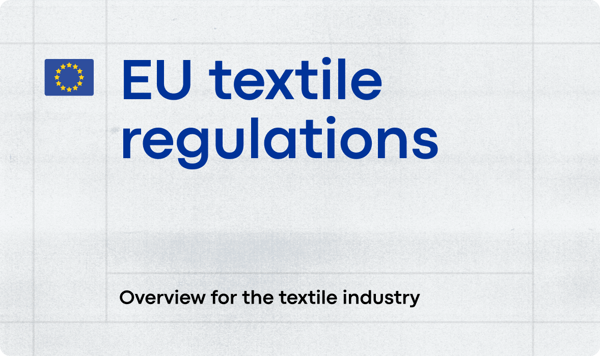"You Ask, We Answer" – brought to you by Carbonfact's Head of Science. Each week Dr. Laurent Vandepaer answers one of your questions about sustainable materials, manufacturing impact, and energy transition in the apparel and footwear industry.
Before joining Carbonfact, Laurent led the integration of LCA into the sustainability and innovation efforts at On and performed LCA for other brands like Arc'teryx. Laurent also worked for several years in research with a PhD focusing on the deployment of LCA at a large scale.
What is the footprint of polyester and what polyester alternatives do you recommend?
Asked by the Head of Sustainability from a sportswear brand
Synthetics, including polyester, nylon, acrylic, and elastane, are among the most widely used materials in the apparel and footwear industry today. These materials are typically derived from fossil fuels, with crude oil serving as their primary feedstock.
Despite their environmental challenges, synthetic materials offer inherent performance attributes – they are durable, stretchable, and moisture-resistant. That is the reason synthetics are particularly valued and widely used in outdoor and athletic apparel.
In order to end the industry’s reliance on virgin fossil fuel-derived synthetic materials, brands will not only l have to focus on new recycling technologies but also support and scale new, innovative, lower-impact materials. This work starts with polyester – the most widespread synthetic fiber with a market share of approximately 57% of global fiber production in 2023.
What is Polyester?
Polyester is a category of polymers connected by ester bonds. The most common type in fashion is Polyethylene Terephthalate (PET). While PET is dominant, it’s important to note that other polyester types exist, which impacts how recycling technologies are developed and applied.

Polyester's appeal extends beyond its affordability. Its versatility makes it widely used in a variety of clothing and accessories. Wool coats are often polyester blends, leather handbags may feature polyester linings, and performance gear relies heavily on polyester-based fabrics for their moisture-wicking and durability properties.
However, given polyester's dominance in the synthetics market, it should be a key focus in the transition away from conventional, fossil fuel-based feedstocks. Traditional polyester is produced using fossil fuel-derived chemicals. This production process has a high carbon footprint and is resource-intensive.
Virgin Polyester: LCA Data & Certifications
Despite polyester’s dominance in the textile industry, there is still lack of certification or standard for virgin polyester, creating little incentive to minimize the extraction, processing, and toxicity impacts of polyester production.
Adding to the challenge, environmental impact assessments often rely on outdated and unrepresentative data. The UNCC’s report from 2021, Identifying Low Carbon Sources of Cotton and Polyester Fibers, raises concerns about the continued use of Plastics Europe’s LCA data, which includes crude oil figures from 2001 and PET production data from 2016.
While refinery processes have remained relatively stable, the sources of crude oil imported by the EU have changed significantly over the past decade. Since GHG emissions from crude oil extraction and refining can vary up to sevenfold depending on location, relying on outdated assumptions risks severely underestimating the true carbon footprint of PET production.
More accurate, region-specific data is essential for a realistic assessment of polyester’s environmental impact. The latest updates to the Ecoinvent database provide a more precise picture of fossil-based PET’s footprint, reinforcing the need for better data integration across industry standards.
Updates in LCA Databases
The latest updates to the Ecoinvent database (versions 3.9 to 3.11) have significantly improved the accuracy of life cycle assessments (LCA) for fossil fuel supply chains and fossil-based plastics, including PET.
- These updates now include methane emissions from extraction and processing, expanding regional data for crude oil and natural gas to cover up to 90% of global crude oil production and 88% of global gas consumption.
- Additionally, trade shifts in 2023 have been integrated into crude oil supply mixes for multiple regions, while coal supply chains have been refined with updated methane emissions, regionalized mining data, and new market differentiation.
These improvements provide a more precise environmental footprint for fossil-derived materials, especially fossil-based plastics like PET.
In parallel, Ecoinvent 3.11 enhances the PET supply chain by introducing recycled PET-based unsaturated polyester (UP) resins, reflecting growing circularity in PET production. Additionally, outdated, aggregated datasets for methyl methacrylate and polymethyl methacrylate, key PET-related chemicals, have been replaced with disaggregated unit processes, improving traceability and alignment with real-world PET manufacturing. As a result of these updates, the carbon footprint of fossil-based PET has increased by a circa 30%, further highlighting the environmental benefits of bio-based and recycled PET alternatives (see the visualized changes below).

![]()
In the EF3.1 database, these improvements do not yet appear to be reflected, as the climate change impact of fossil-based PET is approximately 20% lower than in the latest version of the Ecoinvent database (3.12 kg CO2e ).
There may still be gaps in accuracy that could be improved with more detailed regional and technological data. A common critique is that some supply chain processes may only represent European technologies, potentially limiting accuracy for other regions.
What impacts the emission factor of polyester?
The values explained above are still global averages, and the climate impact of fossil-based PET can vary significantly depending on the country of origin, feedstock type, and refining techniques used. Several factors influence its emissions:
- Energy Source: Facilities powered by coal-intensive grids (such as those in China and India) have higher emission factors compared to those using cleaner energy (such as hydropower in Scandinavian countries).
- Production Efficiency & Regulations: The region of production matters not only because of energy sources but also due to efficiency levels and environmental regulations.
- Extraction Method: Extraction method also factors in; for example, fracked natural gas extraction emits significant amounts of methane, a potent greenhouse gas, making it a higher-impact option than conventionally pumped sources.
Polyester dyeing is also more energy-intensive than natural fibers because the process requires higher temperatures and pressure levels to achieve color fixation.
Now, let’s take a look at the current rising alternatives within the industry.
Recycled polyester
Data Insights
The EF3.1 database provides key insights into the environmental footprint of different PET production methods. PET is the primary plastic resin used to make polyester fibers, produced as small plastic pellets or chips that serve as the foundation for many plastic products and textiles.
These chips are later melted, extruded into fibers, and spun into yarn for fabric production. To make polyester, PET chips are melted and extruded into long, thin fibers. These fibers are then spun into thread or yarn, which is woven or knitted into fabric.
EF3.1 PET analysis:
- Mechanical recycling has the lowest impact (0.68 to 1.56 kgCO2eq/kg) but is limited by degradation and fewer recycling loops compared to chemical processes. Pre-consumer PET is generally lower impact than post-consumer PET due to cleaner input material.
- Chemical recycling ranges from 1.23 to 3.79 kgCO2eq/kg, depending on process efficiency.
- Fossil-based PET has a significant impact at 3.12 kgCO2eq/kg.
- Bio-based PET shows high emissions (3.50 to 3.79 kgCO2eq/kg) due to upstream agricultural processes and intensive transformation steps.

Bottle-based feedstock
The majority of recycled polyester (rPET) today comes from post-consumer plastic bottles, not from textiles. Bottle recycling is an established and scalable process with high-quality outputs.
Nevertheless, increased demand for bottle-based rPET coming from the textile industry risks driving up the production of virgin plastic bottles to maintain the supply chain.
Recycling bottles into textiles downgrades the material, making it unsuitable for food-grade applications in subsequent cycles. This means that it will reach a landfill, an incineration site or nature more rapidly since recycling rates are much lower in the textile industry than in the bottle industry. By using waste materials from another industry, we hinder their circular recycling efforts.
Textile Waste as Feedstock
Using textile waste as feedstock is a more circular approach but significantly more challenging due to several key constraints:
- Feedstock Quality: Textile waste must have high polyester content for the recycling to be economically viable. Feedstock must be clean and uniform for effective recycling.
- Feedstock Uniformity: Most recycling technologies are optimized for homogeneous feedstock streams, leading to material waste when streams are mixed.
- Continuous Supply: Textile recycling facilities require a steady and stable supply chain to maintain efficiency.
Ganni Case Study: Ambercycle, an innovation company specializing in molecular regeneration technology, partnered with GANNI to launch Cycora®. Cycora® is a regenerated polyester made from post-consumer and post-industrial textile waste, using molecular-regeneration technology to convert discarded textiles into virgin-grade (like-new) materials. Read all about it here.
Lululemon Case Study: In 2024, Lululemon introduced its first product made with enzymatically recycled polyester - the limited edition Packable Anorak - developed through a multi-year collaboration with Australian enviro-tech startup Samsara Eco. The jacket’s polyester is created using a combination of enzyme-based recycling from Samsara Eco and captured carbon emissions from LanzaTech, ensuring the same lightweight, quick-drying performance. Read all about it here.

(Lululemon Packable Anorak Earth Day, https://shop.lululemon.com/en-ca/p/mens-jackets-and-hoodies-jackets/Packable-Anorak-Earth-Day/_/prod11710148)
Mechanical Recycling of Textile Waste
- Primary Feedstock: Most mechanical recycling processes currently focus on plastic bottles rather than textile waste.
- Key Player: Unifiis one of the few pioneers focusing on the mechanical recycling of textile products instead of bottles.
- Thermo-Mechanical Recycling: Thermo-mechanical recycling differs from traditional mechanical recycling by using controlled heat and pressure to process polyester textiles without fully melting or breaking down the polymer structure. For example, Tex2Tex™ via Thermo Mechanical Reactor™ recycling enables textile-to-textile polyester recycling, preserving fiber integrity over multiple cycles while being less energy-intensive than chemical recycling.
- Advantage: Mechanical recycling is much less energy-intensive compared to chemical recycling.
- Challenge: Mechanical recycling relies on clean textile inputs that are free from contaminants and faces challenges when processing textiles made from multiple material types. For instance, blends of cotton, polyester, and elastane require expensive and labor-intensive separation processes. Fiber quality also degrades over repeated cycles, limiting long-term recyclability.
Chemical Recycling
Chemical recycling offers a promising pathway for the fiber-to-fiber recycling of polyester. This advanced recycling method breaks polyester down into its original building blocks, enabling the production of high-quality fibers that can be reused in repeated cycles. Chemical recycling addresses many of the limitations of mechanical recycling, such as degraded fiber quality, but it is energy-intensive and faces significant scalability challenges.
There are several types of chemical recycling processes, including hydrolysis, methanolysis, glycolysis, and other emerging techniques (see chart for an overview).
In practice, chemical recycling breaks polyester down into its fundamental building blocks, which are then used to recreate polyester chips for fiber production. However, these outputs often need to be mixed with virgin-origin materials to maintain quality, highlighting an area where innovation and infrastructure improvements are still needed.
Several companies are leading the charge in developing and scaling depolymerization technologies. Here are some key players:
- Carbios (France): Renowned for its enzymatic recycling technology, Carbios uses enzymes to break down polyester fibers into their monomers, facilitating high-quality regeneration.
- Ambercycle (USA): Specializes in textile-to-textile chemical recycling with a focus on scalable fiber regeneration.
- DePoly (Switzerland): Innovates in advanced chemical recycling techniques for polyester regeneration.
- Gre3n (Italy): Develops proprietary chemical recycling processes for polyester.
- Rettake (Germany): Known for its precision chemical recycling methods aimed at delivering consistent fiber quality.
- Jiaren and Cyclone (China): These companies handle additives, colorants, and finishes during recycling. They also produce recycled fibers with performance properties comparable to virgin polyester.
For chemical-recycling processes to operate efficiently, a consistent and high-purity polyester waste stream is crucial. Two notable feedstock sources stand out:
- Stable Feedstock Streams in China: Uniform waste streams from partnerships with schools and government programs in very large volume. The challenge with recycling processes in China comes from its reliance on its carbon-intensive energy mix to run the process which might limit environmental benefits.
- The investigation from the Circular Do Tank notes that the types of textiles that are most likely to have a high purity of PET come from sportswear, duvets, fleece, and mattresses.
Shared Challenge Across All Novel Technologies
The scaling gap and comparability in Life Cycle Assessments (LCAs) are challenges common to all novel technologies. Conventional polyester production has been optimized for decades, making it difficult for emerging technologies to compete in terms of environmental footprint at early stages. It is essential to consider potential progress in these emerging technologies to avoid dismissing them too quickly.
The science team at Carbonfact helps you navigate this challenge by creating bespoke emission factors to accurately reflect the carbon impact of each brand’s specific materials and processes. Read all about it here.
Bio-based Polyester
Bio-based polyester is made from renewable plant-based feedstocks instead of fossil fuels, offering a potential reduction in greenhouse gas emissions. However, its sustainability depends on responsible sourcing and scaling solutions. Some challenges include:
- First-Generation Sugars: Derived from crops like corn or sugarcane, these compete with food production and raise concerns about land use, water consumption, and food security (read more about FLAG emissions here). The CO2e emissions linked to the agricultural part of the supply chain and their transformation into usable feedstock might also be superior to their fossil alternatives.
- Second-Generation Sugars: Extracted from agricultural waste, these avoid competition with food sources but remain underdeveloped and lack widespread adoption.
ASICS Case Study: The ASICS GEL-LYTE™ III CM 1.95 sneaker features a carbon-negative midsole and sock liner made with SEPTON™ BIO-series, a bio-based polymer partially derived from sugarcane, manufactured by Kuraray Co., Ltd. Read all about it here.
(ASICS' GEL-LYTE III CM 1.95, https://www.asics.com/au/en-au/gel-lyte-iii-cm-1.95/p/AOP_1203A409-100.html)
CO₂-Based Polyester
CO₂-based polyester is an emerging innovation that uses captured carbon emissions as a feedstock, reducing reliance on fossil, biobased, or recycled materials. Companies like Fairbrics and LanzaTech are leading efforts to transform CO₂ into polyester fibers, offering an approach to decarbonization.
- Advantage: Reduces reliance on fossil, biobased or recycled feedstock and uses CO2 emissions as a source of carbon. Recycled and second-generation biobased materials are valuable alternatives, their supply can become constrained due to limited waste availability, making it difficult to fully displace fossil-based feedstocks. As a result, alternative carbon sources such as CO₂-based materials are needed to help close the gap.
- Challenge: Limited to small-scale production, with LCAs showing variable results and Scaling and LCA challenges apply here too.
On Case Study: Carbonfact customer On, a Swiss sportswear brand, partnered with biotechnology company LanzaTech to develop a breakthrough material using CO₂-based polyester. By leveraging carbon capture technology, LanzaTech converts industrial emissions into ethanol, which is then transformed into polyester fibers, offering a sustainable alternative to fossil-fuel-derived synthetics. Read all about it here.

(On's Cloudprime, https://www.on.com/en-gb/explore/sustainability/cleancloud)
Curious to learn more inspiring examples from brands like On, New Balance, and Allbirds? Browse our Footwear Decarbonization Playbook here.
Addressing Microplastic Pollution
Microplastic pollution is a growing concern in the textile industry. Regardless of whether polyester is made from virgin materials, recycled bottles, or textile waste, all synthetic fibers shed microplastics during use and washing. This makes microplastic pollution an unavoidable issue across all types of polyester, regardless of how it is produced.
Several initiatives are addressing microplastic pollution, including PEFCR for Footwear and Apparel, the French EcoScore Initiative, The Microfibre Consortium, and the MARILCA Initiative.
Under Armour Case Study: Under Armour has developed an innovative testing methodology to measure fiber shedding at the source, enabling the identification and redevelopment of high-shed materials before they reach the market, supporting its goal of making 75% of fabrics low-shed by 2030. Read all about it here.
At Carbonfact, our science team closely monitors these initiatives and is preparing to integrate microplastic impact modeling into our platform. Once standardized methodologies are ready, brands will be able to factor microplastic emissions into their overall carbon footprint analysis – helping drive better decision-making and sustainability efforts.



-1.jpg?width=203&height=203&name=430471923_947159710328078_7998316763082046126_n%20(1)-1.jpg)



![[Guide] Carbon accounting for fashion, textile, apparel, and footwear companies](https://www.carbonfact.com/hs-fs/hubfs/CA%20-%20Opt1.png?width=600&name=CA%20-%20Opt1.png)
 Angie Wu
Angie Wu

 Lidia Lüttin
Lidia Lüttin
